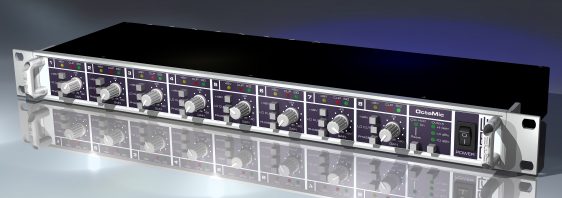 |
|
||||||||||||||||||
|
|||||||||||||||||||
The OctaMic includes extended features, turning it in more than just a combined, dual QuadMic. Thanks to sophisticated discrete Class-A technology, both state-of-the-art microphone preamps offer a pristine sound. Lowest distortion, excellent signal to noise ratio and perfectly linear frequency response transmit and amplify the microphone signals truly unchanged. Additionally, detachable rack mount holders and full battery compatibility make the OctaMic the perfect addition to (not only) the mobile Hammerfall DSP System.
OctaMic offers 8 balanced XLR mic / line inputs. Each channel contains switches for 48V phantom power, a low cut filter and phase reversal. Amplification can be set between 10 and 60 dB. LEDs for signal, clip, and activated phantom power give a complete overview on the unit's status. When the special Clip Hold mode is activated, any detected clip-state will cause the corresponding LED to flash once per second. With this, the user gets a long term peak detection, and no longer needs to constantly watch the LEDs. At the same time momentary overloads are still displayed correctly.
The balanced line level output signal is available at the back of the unit via 8 stereo TRS jacks. The OctaMic also has a 25-pin D-sub connector, which allows for a direct and lockable connection to RME's 8-channel converters ADI-8 PRO and DS, with just one cable. Of course, this connector also provides the ability to use an industry-standard breakout cable for 8 balanced XLR outputs. The included professional switching power supply offers safe operation world wide, even when the power lines are weak or noisy. |
|||||||||||||||||||
|
|||||||||||||||||||
|
The OctaMic D includes the optional OctaMic ADC module, which can also be added to the OctaMic basic version later on. The ADC module adds 8 channels of pristine 192 kHz AD-conversion, available as double ADAT output (S/MUX, up to 96 kHz), and simultaneously via DB-25 connector as 4 AES outputs (up to 192 kHz). The ADC can be clocked internally (master), and externally via word clock and AES sync.
RME's outstanding SteadyClock™ ensures perfect AD-conversion, as jitter on the external sync-sources is nearly completely removed. All settings are done via DIP-switches on the back of the OctaMic D. Analog outputs and both digital outputs operate fully simultaneously. The choice of reference level affects the analog outputs only, the signal/clip indication and the AD-conversion will react only to the Gain-pots. |
|||||||||||||||||||
|
|||||||||||||||||||
|
|||||||||||||||||||
|
|||||||||||||||||||
See your local distributor's website for current price information. |
|||||||||||||||||||
Copyright © 2006 RME. All rights reserved.
RME is a registered trademark. |
|||||||||||||||||||



